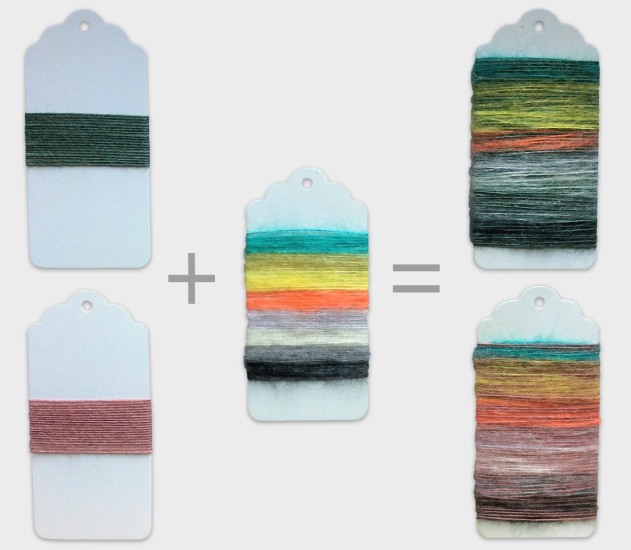Colours are a complex thing. As are fibres. And I enjoy to experiment with both when working with the ITO – fine yarn from Japan yarns. They are thin enough that it is very possible to work with two of them held together, creating a marled effect of colours and texture.
You can, for example, combine a hard with a smooth fibre. I like to spice up Urugami, which has a paper core, with the soft wool-mohair-silk blend Sensai that has a distinct halo. This way the texture of the resulting yarn is a mixture of the two. It has the strength of the Urugami, and the squishyness from Sensai. It is one of my favourite ITO combinations.
But let´s talk colours now, as I promised. Because noone has the time to knit swatches for everything, I just wrapped yarn around a white cardboard gift tag for my examples. It works well enough to illustrate the effect holding two or more threads of yarn together has on the overall colour of the resulting yarn and fabric.

Here I am combining Urugami once in cold Mint and once in warm Mauve with different Sensai colours (from top to bottom Pool Blue, Moss, Lemon, Tangerine, Crocus, White, Smoke Grey, Charcoal). The Sensai colours blend with the Urugami shade resulting in much softer stripes than the Sensai colours alone. Also, that both colours peak out looks very appealing and gives the knitted piece some depth.
When using this technique sparsely, only occasionally adding in a second thread in a knitted piece, the parts worked with two threads, the motifs, will look almost printed. I did that in my Imprinta scarf. The look is so striking that it inspired the shawl´s naming. And in several other designs I have been working with more than one thread at a time also. Among them are North Sea Mist, Goliatha, Abacatha, Rheindrops and Lineares. Knitting any of these will get you started on your journey of exploring fibres and open up your horizon to completely new possibilities in the world of knitting. If I say so it must be true, right?
Another w ay to use the blending effect of working with several strands is to wind a yarn with four strands of one colour. Next wind a yarn with three strands of the base colour and one strand of a contrast colour. Then wind a 2-2 yarn and a 1-3 yarn, and finally a yarn that consists of four strands of only the new colour. You have created your own gradient yarn!
ay to use the blending effect of working with several strands is to wind a yarn with four strands of one colour. Next wind a yarn with three strands of the base colour and one strand of a contrast colour. Then wind a 2-2 yarn and a 1-3 yarn, and finally a yarn that consists of four strands of only the new colour. You have created your own gradient yarn!
Knitters are a creative group of people, I am sure many of you are already planning new projects in your head even as you finish reading. Please tag me on social media, especially instagram, (@janukke) so that I will see them if you are mixing yarns too!

Yes, Jana, you are right – I think I might cast on Imprinta straight away and leave the secret test for a while 😉
Best wishes and thank you for such a lovely blog post
Sandra
[…] hat gestern einen super interessanten Artikel zum Thema Farbeffekte bei mehrfädigen Strickprojekten gepostet. Viele ihrer Designs hat sie mehrfädig mit […]
[…] Some yarn companies go for a very unique and distinctive palette. For example, ITO works with colours that are originally aimed at the Japanese market, and have the appeal of being slightly exotic and unique to us Europeans. It helps that the colours are stylish and tasteful. Also, their fine yarns can easily be held double, which opens up new possibilities for combining colours. […]